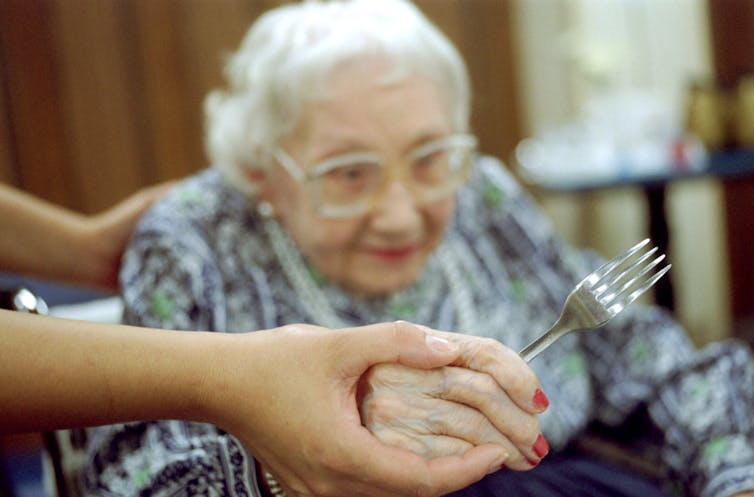Why is nursing home food so bad? Some spend just $6.08 per person a day – that's lower than prison
- Written by Cherie Hugo, Teaching Fellow, Nutrition & Dietetics, Bond University
The Royal Commission into Aged Care Quality and Safety this week turned its attention to food and nutrition. The testimony of maggots in bins and rotting food in refrigerators was horrific.
When so much of a resident’s waking hours is spent either at a meal, or thinking of a meal, the meal can either make or break an elderly person’s day.
So why are some aged care providers still offering residents meals they can’t stomach?
It comes down to three key factors: cost-cutting, aged care funding structures that don’t reward good food and mealtime experiences, and residents not being given a voice. And it has a devastating impact on nutrition.
Read more: Nearly 2 out of 3 nursing homes are understaffed. These 10 charts explain why aged care is in crisis
How much are we spending on residents’ food?
Our research from 2017 found the average food spend in Australian aged care homes was A$6.08 per resident per day. This is the raw food cost for meals and drinks over breakfast, morning tea, lunch, afternoon tea, dinner and supper.
This A$6.08 is almost one-third of the average for older coupled adults living in the community (A$17.25), and less than the average in Australian prisons (A$8.25 per prisoner per day).
Over the time of the study, food spend reduced by A$0.31 per resident per day.
Meanwhile the expenditure on commercial nutrition supplements increased by A$0.50 per resident per day.
Commercial nutrition supplements may be in the form of a powder or liquid to offer additional nutrients. But they can never replace the value of a good meal and mealtime experience.
Read more: What is 'quality' in aged care? Here's what studies (and our readers) say
Cutting food budgets, poor staff training and insufficient staff time preparing food on-site inevitably impacts the quality of food provided.
At the royal commission, chefs spoke about using more frozen and processed meals, choosing poorer quality of meats and serving leftover meals in response to budget cuts.
Malnutrition is common, but we can address it
One in two aged care residents are malnourished and this figure has remained largely the same for the last 20 years.
Malnutrition has many causes – many of which are preventable or can be ameliorated. These include:
- dental issues or ill-fitting dentures
- dementia (because of difficulty swallowing and sensory sensitivities)
- a poorly designed dining environment (such as poor acoustics, uncomfortable furniture, inappropriate crockery and table settings)
- having too few staff members to help residents eat and drink and/or poor staff training
- not supplying modified cutlery and crockery for those who need extra help
- not offering residents food they want to eat or offering inadequate food choices.
 Residents often need help at mealtimes.
Futurewalk/Shutterstock
Residents often need help at mealtimes.
Futurewalk/Shutterstock
My soon-to-be-published research shows disatisfaction with the food service significantly influences how much and what residents eat, and therefore contributes to the risk of malnutrition.
Malnutrition impacts all aspects of care and quality of life. It directly contributes to muscle wasting, reduced strength, heart and lung problems, pressure ulcers, delayed wound healing, increased falls risk and poor response to medications, to name a few.
Food supplements, funding and quality control
Reduced food budgets increase the risk of malnutrition but it’s not the only aged care funding issue related to mealtimes.
Aged care providers are increasingly giving oral nutrition supplements to residents with unplanned weight loss. This is a substandard solution that neglects fundamental aspects of malnutrition and quality of life. For instance, if a resident has lost weight as a result of ill-fitting dentures, offering a supplement will not identify and address the initial cause. And it ends up costing more than improving the quality of food and the residents’ mealtime experience.
Our other soon-to-be-published research shows the benefits of replacing supplements with staff training and offering high-quality food in the right mealtime environment. This approach significantly reduced malnutrition (44% over three months), saved money and improved the overall quality of life of residents.
Read more: So you're thinking of going into a nursing home? Here's what you'll have to pay for
However, aged care funding does not reward quality in food, nutrition and mealtime experience. If a provider does well in these areas, they don’t attract more government funding.
It’s not surprising that organisations under financial pressure naturally focus on aspects that attract funding and often in turn, reduce investment in food.
A research team commissioned by the health department has been investigating how best to change aged care funding. So hopefully we’ll see changes in the future.
 It’s not just about the food. Residents’ mealtime experiences affect their quality of life.
Ranta Images/Shutterstock
It’s not just about the food. Residents’ mealtime experiences affect their quality of life.
Ranta Images/Shutterstock
Aged care residents are unlikely to voice their opinions – they either won’t or can’t speak out. Unhappy residents often fear retribution about complaining – often choosing to accept current care despite feeling unhappy with it.
Read more: How our residential aged-care system doesn't care about older people's emotional needs
We lived in an aged care home. This is what we learned
New Aged Care Quality Standards came into effect on July 1 (I was involved in developing the guidelines to help aged care providers meet these standards).
However, they provide limited guidance for organisations to interpret and make meaningful change when it comes to food, nutrition and mealtime experience. Aged care providers will need extra support to make this happen.
We’ve developed an evidence-based solution, designed with the aged care industry, to address key areas currently holding aged care back. The solution offers tools and identified key areas essential for a happier and more nourishing mealtime.
At the end of 2018, our team lived as residents in an aged care home on and off for three months. As a result of this, and earlier work, we developed three key solutions as part of the Lantern Project:
a food, nutrition and mealtime experience guide for industry with a feedback mechanism for facilities to improve their performance
free monthly meetings for aged care providers and staff to discuss areas affecting food provision
an app that gives staff, residents and providers the chance to share their food experiences. This can be everything from residents rating a meal to staff talking about the dining room or menu. For residents, in particular, this allows them to freely share their experience.
We have built, refined and researched these aspects over the past seven years and are ready to roll them out nationally to help all homes improve aged care food, nutrition and mealtime experience.
Authors: Cherie Hugo, Teaching Fellow, Nutrition & Dietetics, Bond University



















